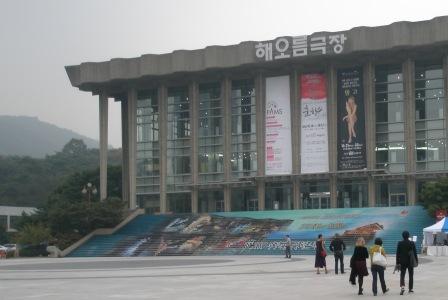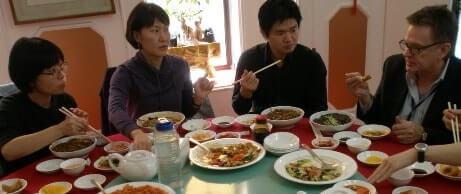NPN Delegation Visits Seoul
May 1, 2011 • 4 minute read
by Elizabeth Doud, with John Herbert

NPN Staff and Partner delegates attended the Performing Arts Market of Seoul from October 10-15, 2010, touring five different art centers in Seoul and neighboring Incheon, attending various performances and showcases of dance, theater, music and multidisciplinary performance, and meeting with a host of presenter/producer peers who form the arts administrative backbone of some of Korea’s most progressive arts organizations.

The purpose of the trip was to conduct an exploratory visit to South Korea to meet with the representatives of the Korean Arts Management Service (KAMS), with whom NPN has been working for two years to craft a pilot project that would expand NPN’s international projects to Asia. KAMS representatives have attended two NPN Annual Meetings: Knoxville, TN in 2009, and the 25th Anniversary meeting in Dallas in 2010.
Travel to an exchange partner’s country is the best way to establish peer relationships among U.S.-based and Korean-based presenters, and to see live work by Korean artists. It also allowed us an opportunity to understand how KAMS (a government-funded agency that is akin to a ministry of culture) funds the arts, interfaces with artists, other independent organizations and even their own government-run organizations. The U.S.-based delegation consisted of Yolanda Cursach of MCA Chicago, Illinois; John Herbert of Legion Arts, Cedar Rapids, Iowa; Scott Turner Scofield from VSA Out North, Anchorage, Alaska, and NPN staff Elizabeth Doud from Miami Dade College Cultural Affairs, Miami, FL, and NPN’s Chief Operating Officer Wesley Montgomery and Director of Interanational Projects Renata Petroni.
The trip was intense and jam-packed with activities, meetings, and tours of privately and publicly owned arts spaces. All of this activity took place within the framework of the Performing Arts Market of Seoul, akin to a Korean Arts Presenters Annual Conference. Overall, the U.S. delegation came away with a sense of who is doing what in contemporary performance in South Korea, but also with a hunch that we had only scratched the surface. With around 22 million inhabitants, Seoul is one of the world’s largest urban centers, and the South Korean government has made it a priority to inject major support into the arts infrastructure of the country. This strategy has translated into a myriad of commissioning opportunities for artists, beautiful new government funded arts spaces, and various festivals that now feature contemporary work. Both government and privately funded organizations that we visited had an array of long-term residency programs, which are supported with live-in facilities incorporated into the structure of the spaces themselves.

John Herbert (pictured right) from Legion Arts in Cedar Rapids shared some further reflections of the trip:
My participation in the Performing Arts Market in Seoul 2010 was interesting and illuminating far beyond my expectations. There are a number of reasons for this, I think. The trip was thoughtfully and efficiently organized; the conference itself was informative and entertaining; and the people we encountered were insightful, generous and kind. As a result of good planning, we were able to see a number of impressive ensembles, some of them well suited to NPN-scale touring.
I thoroughly enjoyed a number of performances that were, to my mind, quite traditional. My general preference, however, is for approaches that combine tradition and innovation. For me, the most memorable performances in this regard included Tacit Group, whose original performances are an engaging and youthful amalgamation of new music, gaming, online iconography and Hangeul calligraphy. I also liked the hip-hop-inflected dance pieces of Jae-Duk Kim. Also very impressive was a performance at the closing reception by Simon Barker and Bae Il-dong, an Australian-Korean duo who manage to fuse Western jazz drumming and traditional Pansori singing.
Somewhat surprisingly, language differences, in these performances and some others, presented much less of a problem than I anticipated. In fact, in the case of Tacit Group, the difference was a distinctive and thought-provoking element in the performance.
Our visits to arts organizations were fascinating in many respects. I was especially struck by the extent to which these visits suggested a widespread commitment to the creative process and long-term support of artists. These values were manifest in the educational programming and writers-in-residence program at Namsan Arts Center; the rehearsal and studio facilities at LIG Art Hall and Doosan Arts Center; and most pointedly in the residency programs at Art Space Mullae and Incheon Art Platform. Especially considering that some of these programs already have an international component, they seem tailor-made for the sort of creative exchanges pioneered in recent years by NPN and La Red. It may be, in fact, that an NPN-Korea partnership might be best launched with creative exchanges, since multi-city touring structures don’t seem to be in place and will probably take some time to develop.
Finally, having participated in several international curatorial trips with NPN, I’d like to make a pitch for these activities. The opportunity to spend a week or so with one’s US colleagues, while exploring the structures, values and programs of our peers in another country, is stimulating and, in my experience, incredibly valuable.
F. John Herbert
November 2010
May 2011